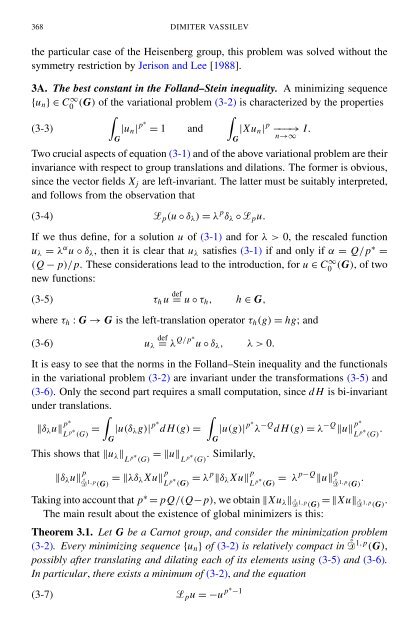Regularity near the characteristic boundary for sub-laplacian operators
Regularity near the characteristic boundary for sub-laplacian operators
Regularity near the characteristic boundary for sub-laplacian operators
You also want an ePaper? Increase the reach of your titles
YUMPU automatically turns print PDFs into web optimized ePapers that Google loves.
368 DIMITER VASSILEV<br />
<strong>the</strong> particular case of <strong>the</strong> Heisenberg group, this problem was solved without <strong>the</strong><br />
symmetry restriction by Jerison and Lee [1988].<br />
3A. The best constant in <strong>the</strong> Folland–Stein inequality. A minimizing sequence<br />
{u n } ∈ C0 ∞ (G) of <strong>the</strong> variational problem (3-2) is characterized by <strong>the</strong> properties<br />
∫<br />
∫<br />
(3-3)<br />
|u n | p∗ = 1 and |Xu n | p −−−→ I.<br />
n→∞<br />
G<br />
Two crucial aspects of equation (3-1) and of <strong>the</strong> above variational problem are <strong>the</strong>ir<br />
invariance with respect to group translations and dilations. The <strong>for</strong>mer is obvious,<br />
since <strong>the</strong> vector fields X j are left-invariant. The latter must be suitably interpreted,<br />
and follows from <strong>the</strong> observation that<br />
(3-4) p (u ◦ δ λ ) = λ p δ λ ◦ p u.<br />
If we thus define, <strong>for</strong> a solution u of (3-1) and <strong>for</strong> λ > 0, <strong>the</strong> rescaled function<br />
u λ = λ α u ◦ δ λ , <strong>the</strong>n it is clear that u λ satisfies (3-1) if and only if α = Q/p ∗ =<br />
(Q − p)/p. These considerations lead to <strong>the</strong> introduction, <strong>for</strong> u ∈ C0 ∞ (G), of two<br />
new functions:<br />
(3-5) τ h u def = u ◦ τ h , h ∈ G,<br />
where τ h : G → G is <strong>the</strong> left-translation operator τ h (g) = hg; and<br />
(3-6) u λ<br />
def<br />
= λ Q/p∗ u ◦ δ λ , λ > 0.<br />
It is easy to see that <strong>the</strong> norms in <strong>the</strong> Folland–Stein inequality and <strong>the</strong> functionals<br />
in <strong>the</strong> variational problem (3-2) are invariant under <strong>the</strong> trans<strong>for</strong>mations (3-5) and<br />
(3-6). Only <strong>the</strong> second part requires a small computation, since d H is bi-invariant<br />
under translations.<br />
‖δ λ u‖ p∗<br />
L p∗ (G) = ∫<br />
G<br />
|u(δ λ g)| p∗ d H(g) =<br />
This shows that ‖u λ ‖ L p ∗ (G) = ‖u‖ L p∗ (G) . Similarly,<br />
∫<br />
G<br />
G<br />
|u(g)| p∗ λ −Q d H(g) = λ −Q ‖u‖ p∗<br />
L p∗ (G) .<br />
‖δ λ u‖ p˚1,p (G) = ‖λδ λXu‖ p L p∗ (G) = λp ‖δ λ Xu‖ p L p∗ (G) = λp−Q ‖u‖ p˚1,p (G) .<br />
Taking into account that p ∗ = pQ/(Q− p), we obtain ‖Xu λ ‖ ˚1,p (G) =‖Xu‖ ˚1,p (G) .<br />
The main result about <strong>the</strong> existence of global minimizers is this:<br />
Theorem 3.1. Let G be a Carnot group, and consider <strong>the</strong> minimization problem<br />
(3-2). Every minimizing sequence {u n } of (3-2) is relatively compact in ˚1,p (G),<br />
possibly after translating and dilating each of its elements using (3-5) and (3-6).<br />
In particular, <strong>the</strong>re exists a minimum of (3-2), and <strong>the</strong> equation<br />
(3-7) p u = −u p∗ −1
















